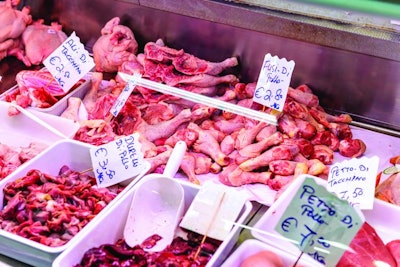
Rising input costs and weakening demand are putting the Italian poultry sector at risk, and this is threatening the country’s self-sufficiency in poultry meat and eggs.
These comments were made by Lara Francisco, director of poultry industry association, Unaitalia, in response to data presented by the agrifood institute ISMEA and presented at the Fieravicola Poultry Forum earlier this year.
ISMEA revealed that, after five years of expansion, both in volume and by value, poultry meat purchases are showing the first signs of contraction. Similarly, the egg sector, which also achieved a strong half decade and performed spectacularly well during lockdowns is also facing difficulties.
The Italian poultry industry, like others, is confronting strongly rising production costs. Over the first three months of this year, ISMEA reports, poultry meat producers saw input costs rise by 21.1%, while the situation was even more dramatic for the egg sector, with costs rising by 50%.
Higher feed costs are having the biggest impact on producers, rising by 33% over the first three months of the year. For April, feed costs were reported to be 40% higher than a year earlier.
While there may be some relief for Italy’s poultry producers, with higher production costs gradually being passed on along the value chain to final point of sale, this has not been the case for egg producers, and prices have not risen quickly enough to protect margins.
Turnaround in fortunes
The last five years have seen the volume of chicken meat bought in Italy rise by 9%, while the industry achieved an even more impressive 19% increase by value, outperforming other types of meat and reflecting a shift to higher value products.
The first three months of this year, however, witnessed a change in consumer behavior in response to prices that are 15% higher compared to 2021 and 19% higher compared to 2019. The first signs of contraction would appear to be emerging. By value, sales may have risen by 4%, but by volume they were back to pre-pandemic levels.
A similar situation has occurred in the market for eggs. Expenditure on eggs grew by 20% over the last five years, as consumers increasingly turned to added value eggs, such as organic or barn raised. However, last year, sales were down by 10% both by volume and by value and this trend has continued into 2022.

What really lies behind the difficulties?
According to Dr. Fabio Bravo, ISMEA director of services for rural development, while the increase in feed costs can be attributed to the Russian invasion of Ukraine, the reality is a little more complex.
He noted that only a small fraction of the corn used to produce feed in Italy comes from Ukraine and that, globally, Ukraine only makes up a small percentage of global supplies. He suggested that a degree of speculation was driving prices higher.
With the exception of sunflower oil, raw material availability should not really be a problem, he continued, although much will depend on future world harvests. Most observers believe that the next harvest will be normal, so the market should rebalance.
Where consumption is concerned, delegates heard that the reduction in 2021 needed to be viewed in the context of the strong increases recorded during the lockdowns of 2020.
Stefano Gagliardi, of the egg producers’ association Assoavi, pointed out that if 2021 is compared with 2019, rather than with 2020, a small increase in sales becomes apparent, with volumes 1.9% higher. Sales were stable in the large retailer channel while they rose in discounters.
There may have been a slight contraction in volumes when comparing retail sales over the first three months of this year compared to the first quarter of 2021, but this was, in part, due to more eggs being consumed out of home. While consumption out of home may not have reached pre-pandemic levels, it is, nevertheless, making an important recovery.

Francisco, however, sounded a note of caution. She reiterated that poultry was among the sectors most hit by rising production costs. This increase in costs, combined with a contraction in retail sales, was seeing the excellent progress made by the industry over the last two years wiped out and putting the industry’s profitability at risk.
Italy’s poultry sector to end year higher


















